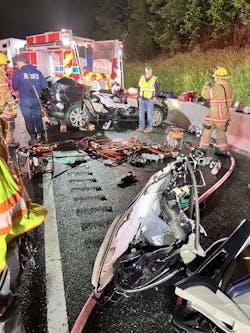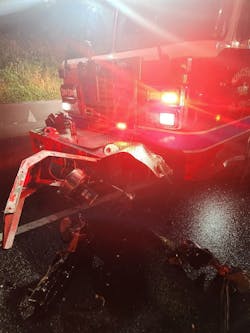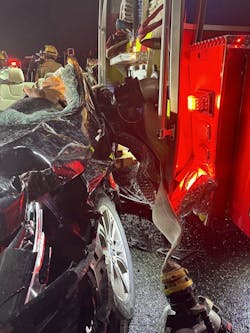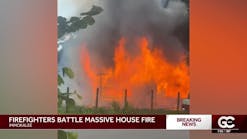It seems that we hear about a fire or EMS unit being struck on a daily basis. Although high-speed roadways predictably are the most dangerous risk, fire and EMS unit collisions happen on all roadways. Why? My nonscientific observation is that civilian drivers aren’t paying attention or are drunk and/or stoned or a combination of all of that.
The Baltimore County, MD, Fire Department (BCoFD) provides fire and emergency medical services to more than 800,000 residents. The department consists of 25 county-operated, fully career staffed stations and 29 volunteer companies. One such volunteer company is the Kingsville Volunteer Fire Company (KVFC) Station 48. With more than 100 members, the KVFC responds to more than 1,700 calls per year. The KVFC consistently rates among the top responding volunteer companies in Baltimore County, usually at or above a 95 percent response rate.
My sincere thanks to the commander of the KVFC, Capt. John Cooke, Sr. Lt. Brendan Berkeridge, Lt. Donald Coster, Drivers Noah Brown and Michael Seifert, and Firefighters Leah Conger, Emanuel Kenion and Jack Miller, who were on scene when Engine 481 was struck, as well as all of the members of the KVFC, the BCoFD, the Harford County Volunteer Fire and EMS Association (HCVFA), the Joppa-Magnolia Volunteer Fire Company (JMVFC), the White Marsh Volunteer Fire Company (WMVFC) and BCoFD communications.
The response and crash
Baltimore County policy in responses to interstates includes a major suppression apparatus in each direction of travel, to cover the highway in its entirety in both directions of the reported incident, and a second-arriving major suppression piece that also serves as barrier protection for the operating crews.
At 8:11 p.m. on May 10, 2024, KVFC E481, which was a new apparatus that was placed into service just weeks before this incident, responded with KVFC’s Squad 483 (rescue-engine) and Medic Ambulance 485 and HCVFA Engine 813 to the report of an adult male having a diabetic emergency on the right shoulder of Interstate 95. Initial reports stated that the incident was located southbound in the area of the Baltimore County/Harford County line. The weather at the time was rainy. HCVFA E813 arrived first and began patient care. E481, S483 and M485 arrived at 8:25 p.m. M485 positioned in front of the incident, and E481 and S483 took up blocking positions at a 45-degree angle, closing the right shoulder and the fourth lane of I-95. The crew of E481 and S483 remained belted and inside of their apparatus at the direction of the officer in charge to limit the number of personnel who were on the roadway.
Approximately 30–60 seconds after the arrival of KVFC units, the driver’s door and bumper of S483 were struck by a passenger vehicle, which caused the latter to spin and slide into the back of E481. This resulted in significant damage to the front of S483 and rear of E481. Two people who were in the passenger vehicle were rendered unconscious and were trapped. The crews from E481 and S483 all confirmed with each other that they were OK, and extrication efforts commenced. Additional resources were requested, and I-95 South was shut down completely by Maryland State Police and other responding fire apparatus.
The patients were extricated about 20 minutes after the crash. Eight KVFC members (four from E481 and four from S483) were transported later to the R Adams Shock Trauma Center with minor injuries. The cause of the crash was under investigation as of press time.
Account from Cooke
The night began normally. We decided to conduct spontaneous training on a cloudy/overcast evening with projected rain. Companies were alerted for a diabetic episode initially reported as southbound on I-95 in the area of the Baltimore County/Harford County line. The response was KVFC, responsible for northbound coverage, and JMVFC, responsible for southbound coverage. Units investigated the area and received updated information. The incident was located in the southbound slow shoulder lane. All companies continued.
E813 arrived first and initiated patient care. Moments later, E481 arrived and positioned to block the shoulder and the fourth lane at a 45-degree angle. S483 arrived seconds later and positioned behind E481, mirroring the same placement of E481. I ordered E481’s crew to remain within the cab. Coster ordered S483 to do the same.
Seconds later, the driver of E481 saw in the driver’s side mirror S483 struck by a vehicle. The driver of E481 alerted the crews to “Hold on. Members bracing for impact.” The sheer force of the initial impact was so significant that thoughts of a semitrailer colliding with the apparatus came to mind. E481 came to rest, and the jolt from the energy of impact was felt through my spine and left side. I immediately asked the crew, “Is everyone OK?” Berkeridge said, “I think so. Good.”
I immediately notified dispatch and requested a medic unit.
I will remember forever making my way to the rear of the engine to assess for injuries and damage. Walking the 30 feet from the officer’s door to the rear of the engine were the longest moments of my life. I was certain by the sound of the crash before we were struck that S483 was destroyed. I called Coster on the radio. He confirmed that they were struck but all were OK.
I noted S483 in the distance with such relief, seeing that the cab was intact and upright, although with obvious front-end damage to the bumper. I also noted that a civilian vehicle was sideways and embedded into the rear of E481. In my continued size-up, I noted two occupants, both of whom were unconscious and trapped.
I assumed command of the incident. I requested a rescue assignment and requested the rescue tools from S483. We began to stabilize the vehicle and provide patient care simultaneous to the rescue tools being set up. Members from the KVFC—the same members who just were involved in a significant motor vehicle collision (MVC)—began to remove the passenger-side doors and a portion of the roof of the passenger vehicle to prepare for removal.
The rescue assignment (entrapment), in addition to medic units, an EMS supervisor and a battalion chief, brought units from JMVFC Truck 8 and BCoFD Truck 15. WMVFC Engine 201 played a vital role in ensuring that I-95 was shut down, to facilitate equipment movement. The crew also assisted with patient care.
Flawless teamwork among the companies provided a successful extrication of two patients within 20 minutes of the initial impact.
Comments from Goldfeder
When I spoke with Cooke and Berkeridge, I asked, “Why were no members injured?” It appears that’s because there was no wandering around or freelancing. No members got out of the rig on their own. They maintained discipline.
All of us want to “make things better” for those who need us, but training, policy and discipline make it so we can help without becoming part of the emergency.
The members remained in the rig until they were given direction. It was that simple: policy, discipline, command/control. We often think of these things on the fireground, but they are applicable on every scene, particularly crashes.
Additional incident takeaways include:
Your training. In addition to the no-cost, excellent training that’s available from Emergency Responder Safety Institute (ERSI)—which every North American firefighter should have)—it’s important to drill and train on your department policies regularly. Although we might think of drills as throwing ladders, search and stretching hoselines, traffic crash/roadway
responses must be drilled on as well.
Follow policy. E481’s and S483’s personnel all remained in the apparatus, limiting personnel who were on the highway and, most likely, saving their life. (For sample policies, visit ESRI at respondersafety.com.)
Apparatus positioning. The vehicle that struck S483 was propelled in the direction of the scene where the personnel were operating. E481 prevented the vehicle from reaching the scene of the original incident.
Apparatus, not people. Heavy-duty apparatus/suppression units—not people—should be used to block traffic. Never allow personnel to “jump out into traffic” in an attempt to manage or control it. Policy along with training can minimize risk.
Get on, get off. Understand the importance of limiting on-scene time of apparatus and personnel on highway incidents. Once roles are completed, clear the scene. If members must protect the scene after services are complete, ensure they are accounted for and safe.
To shut down or not. The risk/benefit of shutting down a highway in its entirety to provide a secure scene always must be a consideration, in coordination with law enforcement. If the situation warrants, follow your policy, and with extreme caution and coordination, shut down.
Nonoperational actions. While on scene, we often collect information for reports, patient care information, etc. Whenever this can be done in the safety/protection of a rig or away from the highway, do it.
Resources. Make the value of resources, including state highway safety units for traffic management, part of response policy. Ensure drivers of major suppression apparatus remain in the apparatus, always observing traffic that forms before the incident and alerting crews who are outside of impending danger. The latter can be done via multiple blasts of the air horn.
Note: High-speed roadways are extremely dangerous for volunteer fire-police traffic units, many of which operate personal vehicles. Fire-police officers have proven to be of great help in managing traffic, but the use of those units should be part of a clear risk-management plan for high-speed roadway operations.
Keep sizing up. Ultimately, there’s no solution for a distracted driver or one who is under the influence of alcohol or drugs. We must position apparatus to buffer the scene and to create a safe operating space for crews. Since this incident, the KVFC responded to multiple calls for service on I-95. The department already started to reeducate its membership on how it will operate on highway incidents moving forward and to provide useful information to protect crews while they operate.
Thoughts from Emergency Responder Safety Institute
No one has a good overview of how many times struck-by incidents occur, how many responders are injured, and how much money is spent to repair and replace damaged or destroyed emergency vehicles. The best that the Emergency Responder Safety Institute (ERSI) has been capable of doing is track struck-by fatalities. (As of press time, 19 fatalities occurred in 2024.) To aid ESRI in its efforts, departments are asked to report struck-by incidents and secondary crashes at ReportStruckBy.com. It takes about four minutes to file a report.
In regard to shutting down a highway, ESRI urges responders to request assistance from law enforcement and the department of transportation, to protect the back of the queue with safety service patrols (SSP), if available, or police and DOT vehicles and message boards along the highway. Citizen drivers who are at the back of the queue, which changes constantly, are in a dangerous position from the same “D” drivers (dangerous, disgruntled, disrespectful, driverless) for which blocking apparatus are used to protect responders and victims of the original incident.
Many departments of transportation have the capability to report road closures to Waze, Google Maps and other GPS systems through their traffic operation centers. Fire departments should feel comfortable collaborating with their DOT to understand what capabilities that they have to notify the public of incidents and road closures.
Furthermore, nobody likes to set cones and flares at incident scenes, particularly on highways. That said, citizen drivers who see cones/flares tend to steer around them or “wake up” when they hit one, which can prevent the drivers from striking blocking apparatus. Requesting SSPs to set up cone tapers as soon as possible can help a lot.
“It’s time for the DOTs to step up their incident response capabilities and performances,” Jack Sullivan, who is director of training, ESRI, says.
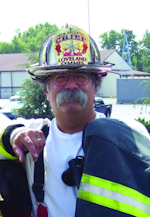
Billy Goldfeder
BILLY GOLDFEDER, EFO, who is a Firehouse contributing editor, has been a firefighter since 1973 and a chief officer since 1982. He is deputy fire chief of the Loveland-Symmes Fire Department in Ohio, which is an ISO Class 1, CPSE and CAAS-accredited department. Goldfeder has served on numerous NFPA and International Association of Fire Chiefs (IAFC) committees. He is on the board of directors of the IAFC Safety, Health and Survival Section and the National Fallen Firefighters Foundation.
